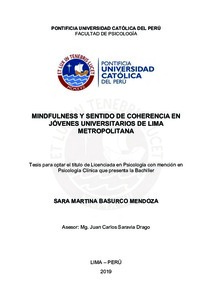| dc.contributor.advisor | Saravia Drago, Juan Carlos | es_ES |
| dc.contributor.author | Basurco Mendoza, Sara Martina | es_ES |
| dc.date.accessioned | 2019-07-15T14:42:49Z | es_ES |
| dc.date.available | 2019-07-15T14:42:49Z | es_ES |
| dc.date.created | 2019 | es_ES |
| dc.date.issued | 2019-07-15 | es_ES |
| dc.identifier.uri | http://hdl.handle.net/20.500.12404/14576 | |
| dc.description.abstract | Los jóvenes universitarios están experimentando diversas manifestaciones de malestar y
estrés, lo cual no solo influye en su salud y bienestar, sino también en la formación y
establecimiento de su identidad. La presente investigación plantea que el mindfulness y el
sentido de coherencia pueden actuar como herramientas pertinentes y complementarias para
enfrentar dicho problema. El objetivo de este trabajo es analizar la relación de ambos
constructos y sus áreas respectivas en una muestra de 184 estudiantes de una universidad
privada limeña. Dichos participantes fueron 88 hombres y 96 mujeres con edades entre 17 y
21 años que pertenecían a la facultad de Letras o de Ciencias. Todos completaron una ficha
sociodemográfica y los cuestionarios del FFMQ (Baer et. al, 2006) y del SOC-13 (Antonovsky,
1993) en una única aplicación grupal. Los resultados muestran relaciones directas,
significativas y de mediana intensidad (Cohen, 1988) entre Mindfulness y Comprensibilidad
(r=.34, p<.001), Manejabilidad (r=.37, p<.001) y Significatividad (r=.39, p<.001). Esto puede
deberse a que ambos constructos están asociados con la salud mental y tienen un rol
semejante en procesos de regulación afectiva y del estrés. Por otro lado, Comprensibilidad,
Manejabilidad, Significatividad, facultad y la interacción entre Comprensibilidad y facultad
explican la varianza total del mindfulness (R2 ajustado=.33, F(5, 177)=17.47, p<.001) en grado
moderado según Cohen (1988). Algunas posibles explicaciones son las comparaciones
sociales y las competencias socioemocionales de los alumnos, las diferencias entre las
facultades académicas y los momentos de aplicación de los cuestionarios. | es_ES |
| dc.description.abstract | University students are experiencing various manifestations of discomfort and stress, which
not only influences their health and well-being, but also has an impact on the formation and
establishment of their identity. The present investigation proposes that mindfulness and sense
of coherence can act as relevant and complementary tools to face the problem in question.
The purpose of this study is to analyze the relationship of both constructs and their respective
areas in a sample of 184 students from a private university in Lima. These participants were
88 men and 96 women between 17 and 21 years of age that belonged to the College of Letters
or Sciences. All the students completed a sociodemographic form, the FFMQ (Baer et al.,
2006) and SOC-13 (Antonovsky, 1993) questionnaires in a single group application. The
results show direct, significant and medium intensity relationships (Cohen, 1988) between
Mindfulness and Comprehensibility (r=.34, p<.001), Manageability (r=.37, p<.001) and
Significance (r=.39, p<.001). This may be due to the fact that both constructs are associated
with mental health and have a similar role in affect and stress regulation processes. On the
other hand, Comprehensibility, Manageability, Significance, faculty and the interaction
between Comprehensibility and faculty explain the total variance of Mindfulness (adjusted
R2=.31, F(5, 177)=17.47, p<.001) to a moderate degree according to Cohen (1988). Some
possible explanations are the student’s social comparisons and socioemotional competencies,
the differences between the academic faculties and the application’s moments of the
questionnaires. | es_ES |
| dc.language.iso | spa | es_ES |
| dc.publisher | Pontificia Universidad Católica del Perú | es_ES |
| dc.rights | Atribución-NoComercial 2.5 Perú | * |
| dc.rights | info:eu-repo/semantics/openAccess | es_ES |
| dc.rights.uri | http://creativecommons.org/licenses/by-nc/2.5/pe/ | * |
| dc.subject | Atención | es_ES |
| dc.subject | Sentido de coherencia | es_ES |
| dc.subject | Estudiantes universitarios--Investigaciones | es_ES |
| dc.title | Mindfulness y sentido de coherencia en jóvenes universitarios de Lima Metropolitana | es_ES |
| dc.type | info:eu-repo/semantics/bachelorThesis | es_ES |
| thesis.degree.name | Licenciado en Psicología con mención en Psicología Clínica | es_ES |
| thesis.degree.level | Título Profesional | es_ES |
| thesis.degree.grantor | Pontificia Universidad Católica del Perú. Facultad de Psicología | es_ES |
| thesis.degree.discipline | Psicología con mención en Psicología Clínica | es_ES |
| renati.discipline | 313026 | es_ES |
| renati.level | https://purl.org/pe-repo/renati/level#tituloProfesional | es_ES |
| renati.type | http://purl.org/pe-repo/renati/type#tesis | es_ES |
| dc.publisher.country | PE | es_ES |
| dc.subject.ocde | https://purl.org/pe-repo/ocde/ford#5.01.00 | es_ES |






